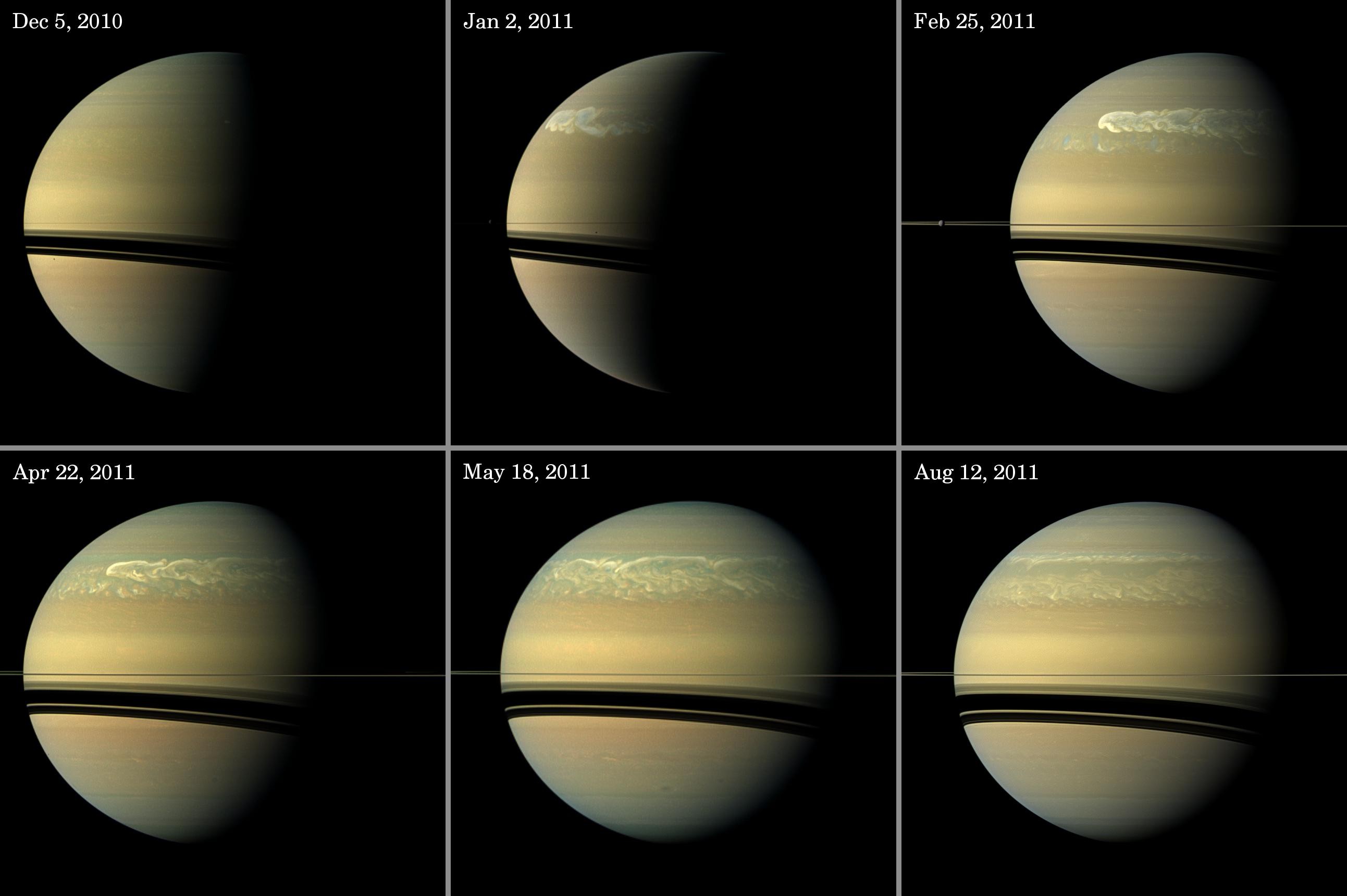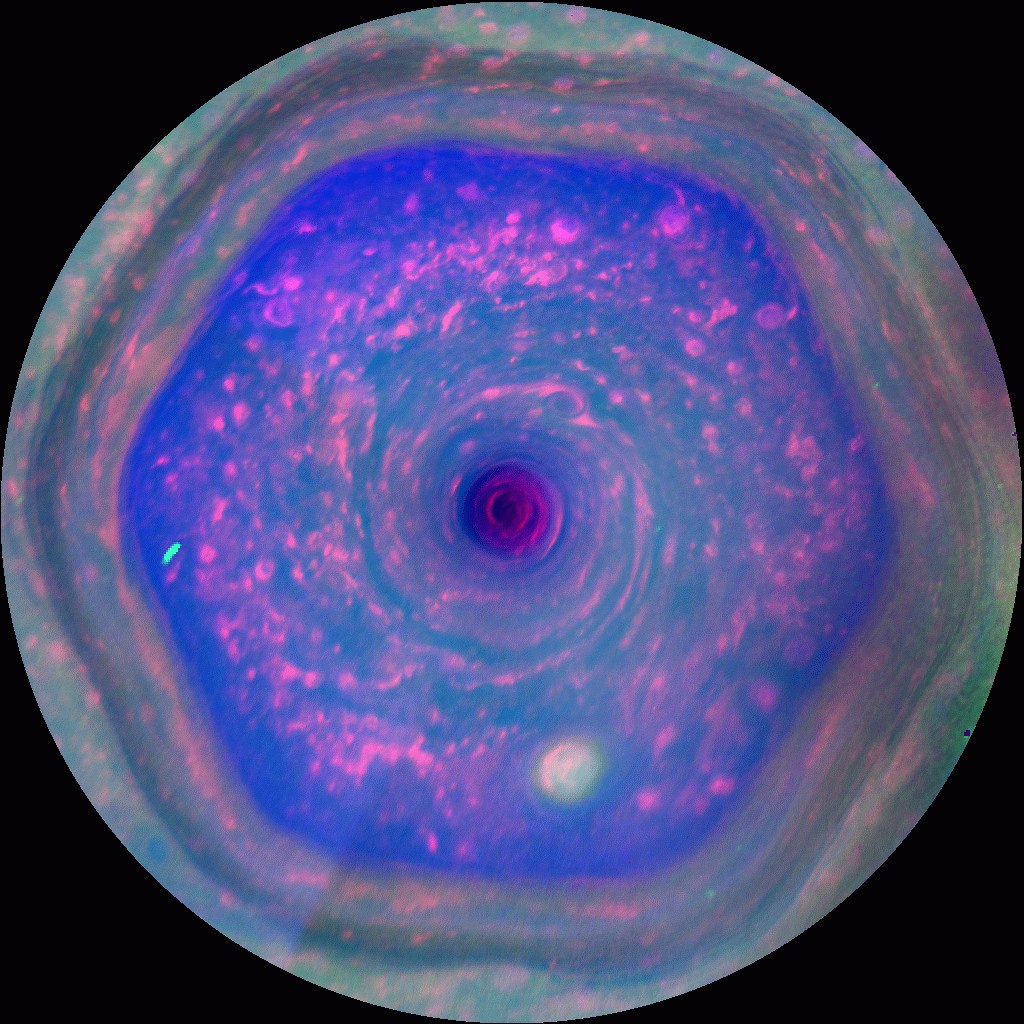Navigating the extreme temperatures of our solar system can be challenging, but COMPARE.EDU.VN is here to offer a clear comparison between Saturn’s frigid climate and Earth’s more temperate conditions. We will explore the temperature differences between these two planets, consider their atmospheric compositions, and examine the factors that influence their climates, offering you information for space science research and comparative planetology. Discover insights for informed decisions about planetary environments and space exploration.
1. What is the Average Temperature on Saturn?
The average temperature on Saturn is approximately -220°F (-140°C). This extreme cold is due to Saturn’s great distance from the Sun. Lacking a true surface, this temperature is measured at a level in Saturn’s atmosphere equivalent in pressure to sea level on Earth.
Saturn’s atmosphere, composed mostly of hydrogen and helium, doesn’t retain heat as effectively as Earth’s atmosphere. Solar radiation weakens as it travels farther from the Sun, which contributes to the planet’s freezing temperatures. Saturn’s rapid rotation and strong winds also play roles in distributing the limited heat it receives from the Sun.
2. How Does Earth’s Temperature Compare to Saturn’s?
Earth boasts a much warmer average surface temperature of 59°F (15°C), creating an environment conducive to liquid water and life as we know it. This significant difference in temperature is primarily because Earth is closer to the Sun, allowing it to receive more direct sunlight. Earth’s atmosphere, a mixture of nitrogen, oxygen, and other gases, traps heat through the greenhouse effect, further moderating temperatures.
The contrast between Earth and Saturn underscores the importance of distance from the Sun and atmospheric composition in determining a planet’s climate. Earth’s conditions permit a wide range of biological processes. Saturn’s do not.
3. What Factors Influence Saturn’s Extremely Cold Temperatures?
Several factors contribute to Saturn’s frigid temperatures:
- Distance from the Sun: Orbiting approximately 886 million miles (1.4 billion kilometers) from the Sun, Saturn receives significantly less solar energy than Earth.
- Atmospheric Composition: Saturn’s atmosphere consists mainly of hydrogen and helium, which are less effective at trapping heat compared to the gases in Earth’s atmosphere.
- Lack of a Solid Surface: Without a solid surface to absorb and retain heat, Saturn’s atmospheric temperature remains consistently low.
- Rapid Rotation and Winds: Saturn’s fast rotation (about 10.7 hours) and strong winds (up to 1,600 feet per second) distribute heat rapidly. This prevents the buildup of warmer regions.
4. What Are the Temperature Extremes on Saturn?
While Saturn’s average temperature hovers around -220°F (-140°C), there can be variations within its atmosphere. Temperatures in the upper atmosphere can drop even lower, especially at the poles. Due to the planet’s axial tilt of about 26.7 degrees, seasonal variations occur, but they are minimal compared to those on Earth.
Saturn’s poles exhibit unique features, such as the hexagon-shaped jet stream at the north pole. This atmospheric phenomenon influences local temperatures and wind patterns, showcasing the complex dynamics of Saturn’s climate.
5. How Does Saturn’s Atmosphere Contribute to Its Temperature?
Saturn’s atmosphere is predominantly hydrogen and helium, with trace amounts of other elements. These gases do not trap heat as efficiently as the greenhouse gases present in Earth’s atmosphere, such as carbon dioxide and water vapor. The lack of significant greenhouse effect contributes to Saturn’s overall low temperature.
The planet’s density is so low that it would float in water if a sufficiently large body of water existed. The atmospheric layers, influenced by pressure and temperature, create distinct cloud formations and wind patterns, affecting the distribution of heat.
6. What Role Do Saturn’s Rings Play in Its Temperature Profile?
Saturn’s rings, composed of ice particles, dust, and rocky debris, do not significantly contribute to its temperature. These rings primarily reflect sunlight, which has a minor impact on the planet’s overall energy balance. The rings extend hundreds of thousands of kilometers from the planet, yet they are remarkably thin, averaging only about 10 meters in thickness.
Studying the rings provides valuable insights into the dynamics of Saturn’s magnetosphere and its interactions with solar radiation. Data from missions like Cassini continue to enhance our understanding of these iconic structures.
7. How Does Sunlight Intensity Affect Saturn’s Temperature Compared to Earth’s?
At Saturn’s distance from the Sun, the intensity of sunlight is significantly weaker than on Earth. Earth receives approximately 1000 watts per square meter of solar energy at its surface on a clear day, while Saturn receives only about 15 watts per square meter. This drastic reduction in solar energy is a key factor in Saturn’s lower temperature.
The inverse square law dictates that the intensity of light decreases with the square of the distance from the source. Consequently, the amount of solar radiation reaching Saturn is substantially reduced, impacting its thermal environment.
8. Are There Any Internal Heat Sources on Saturn That Affect Its Temperature?
Saturn emits more heat than it receives from the Sun, suggesting an internal heat source. This internal heat is generated primarily through the compression of the planet’s interior, a process known as the Kelvin-Helmholtz mechanism. As Saturn’s immense mass compresses under its own gravity, it generates heat that radiates outward.
This internal heat source contributes to Saturn’s atmospheric dynamics and influences its temperature profile, although its overall impact is less significant than the effect of solar radiation.
9. How Do Saturn’s Seasons Compare to Earth’s in Terms of Temperature Variation?
Saturn experiences seasons due to its axial tilt, similar to Earth. However, the seasonal temperature variations on Saturn are much less pronounced. Saturn’s greater distance from the Sun moderates the impact of seasonal changes on its temperature. A complete orbit around the Sun takes approximately 29.5 Earth years, making each season last over seven Earth years.
Although Saturn’s axial tilt is about 26.7 degrees, close to Earth’s 23.5 degrees, its longer orbital period means that the temperature variations are gradual and subtle.
10. What Would Happen to Earth’s Temperature if It Were Located at Saturn’s Distance From the Sun?
If Earth were located at Saturn’s distance from the Sun, it would become a frozen world. The reduced solar radiation would cause Earth’s average temperature to plummet far below freezing, likely resulting in a global ice age. Earth’s oceans would freeze over, and its atmosphere would undergo significant changes, potentially leading to a collapse of the biosphere.
Life as we know it would not be sustainable under such conditions. This thought experiment underscores the delicate balance required for a planet to support life, emphasizing the crucial role of distance from the Sun and atmospheric properties.
11. How Do Scientists Measure the Temperature of Saturn?
Scientists use a variety of methods to measure Saturn’s temperature, including:
- Infrared Spectroscopy: Analyzing the infrared radiation emitted by Saturn’s atmosphere to determine its temperature profile.
- Radio Astronomy: Measuring radio waves emitted from Saturn to infer temperature and atmospheric conditions.
- Spacecraft Missions: Utilizing spacecraft like Cassini, which carried instruments to directly measure temperature and other atmospheric properties.
Data from these methods help scientists create detailed temperature maps of Saturn’s atmosphere. This enhances our understanding of its climate dynamics.
12. What Are Some Notable Temperature-Related Discoveries About Saturn?
Notable temperature-related discoveries about Saturn include:
- The Hexagon Jet Stream: A stable, six-sided pattern at Saturn’s north pole with unique temperature and wind characteristics.
- Internal Heat Source: Saturn emits more heat than it receives from the Sun, indicating an internal heat source.
- Seasonal Variations: Although subtle, Saturn experiences seasonal temperature changes due to its axial tilt.
These discoveries highlight the complexity of Saturn’s climate system and provide valuable insights into planetary atmospheres.
13. How Does the Temperature of Saturn Compare to Other Planets in the Solar System?
Saturn is one of the coldest planets in our solar system, with an average temperature of -220°F (-140°C). Here’s a comparison with other planets:
| Planet | Average Temperature |
|---|---|
| Mercury | 333°F (167°C) (Day), -290°F (-180°C) (Night) |
| Venus | 867°F (464°C) |
| Earth | 59°F (15°C) |
| Mars | -85°F (-65°C) |
| Jupiter | -166°F (-110°C) |
| Saturn | -220°F (-140°C) |
| Uranus | -320°F (-195°C) |
| Neptune | -330°F (-200°C) |
| Pluto | -375°F (-225°C) |


As the table shows, Saturn’s temperature is colder than Jupiter, Mars, and Earth. Only Uranus, Neptune, and Pluto have lower average temperatures.
14. How Might Future Space Missions Enhance Our Understanding of Saturn’s Temperature?
Future space missions could provide more detailed data on Saturn’s temperature by:
- Advanced Instrumentation: Developing more sophisticated instruments to measure temperature at different depths within Saturn’s atmosphere.
- Long-Term Monitoring: Establishing long-term monitoring stations to track seasonal variations and climate changes.
- Atmospheric Probes: Deploying probes to directly sample and measure temperature and composition within Saturn’s atmosphere.
These missions could revolutionize our understanding of Saturn’s climate and its place within the solar system.
15. What Are the Implications of Saturn’s Temperature for Potential Life Forms?
Saturn’s extremely cold temperatures and lack of a solid surface make it highly unlikely to support life as we know it. Liquid water, essential for most known life forms, cannot exist under such conditions. However, some scientists speculate that subsurface oceans on Saturn’s moons, such as Enceladus and Titan, might harbor microbial life.
The search for life beyond Earth focuses on identifying environments with conditions conducive to liquid water, energy sources, and organic molecules. Saturn itself does not meet these criteria.
16. Can We Learn Anything About Earth’s Climate by Studying Saturn’s Temperature?
Studying Saturn’s temperature and atmospheric dynamics can provide valuable insights into planetary climate systems. By comparing Saturn’s climate to Earth’s, scientists can better understand the factors that influence temperature, weather patterns, and atmospheric processes.
Understanding the differences in atmospheric composition, energy balance, and internal heat sources between the two planets can help refine climate models and improve predictions about Earth’s future climate.
17. What Are the Effects of Saturn’s Winds on Its Temperature Distribution?
Saturn’s winds, among the fastest in the solar system, play a crucial role in distributing heat around the planet. These winds can reach speeds of up to 1,600 feet per second (500 meters per second) in the equatorial region. Such rapid air movement helps to prevent the formation of localized hot spots.
The strong zonal winds and atmospheric turbulence contribute to a relatively uniform temperature distribution, particularly in the upper atmosphere. These winds also influence the formation and behavior of cloud patterns and jet streams, which can affect regional temperatures.
18. How Does the Tilt of Saturn’s Axis Influence Its Temperature Zones?
The tilt of Saturn’s axis, approximately 26.7 degrees, leads to seasonal variations in the amount of sunlight received by different regions of the planet. This tilt causes the northern and southern hemispheres to experience alternating periods of more direct sunlight and reduced solar radiation.
As a result, temperature zones shift over the course of Saturn’s nearly 30-year orbit around the Sun. While these seasonal temperature differences are less extreme than those on Earth, they still influence atmospheric dynamics and weather patterns on Saturn.
19. What is the Significance of Saturn’s Hexagon in Terms of Temperature?
Saturn’s hexagon, a unique atmospheric feature at its north pole, is a persistent six-sided jet stream spanning about 20,000 miles (30,000 kilometers) across. The temperatures inside the hexagon are different from the surrounding atmosphere, with the vortex at its center exhibiting higher temperatures.
This hexagon-shaped pattern influences local temperatures and wind patterns, making it a key area of study for understanding Saturn’s atmospheric dynamics. The persistence of the hexagon over many years suggests that it is a stable and fundamental feature of Saturn’s climate.
20. How Does the Temperature of Saturn’s Moons Compare to the Planet Itself?
Saturn’s moons have varying temperatures, but most are extremely cold due to their distance from the Sun. Titan, Saturn’s largest moon, has a surface temperature of about -290°F (-179°C). Enceladus, another notable moon, has a surface temperature of around -320°F (-198°C).
These low temperatures are due to the moons’ distance from the Sun and their thin atmospheres, which are unable to trap heat efficiently. Some moons, like Enceladus, have internal activity that can create warmer regions, particularly near geysers that erupt with water vapor and ice particles.
21. What Advanced Technologies Help Scientists Study Saturn’s Temperature From Earth?
From Earth, scientists use several advanced technologies to study Saturn’s temperature:
- Large Telescopes: Ground-based telescopes with advanced infrared sensors can measure the thermal radiation emitted by Saturn.
- Radio Telescopes: These instruments detect radio waves from Saturn, providing information about its atmospheric temperature and composition.
- Adaptive Optics: Systems that correct for atmospheric distortion, allowing for clearer and more precise measurements of Saturn’s temperature.
These technologies enable scientists to monitor Saturn’s climate remotely and track long-term temperature changes.
22. How Do Saturn’s Upper Atmospheric Temperatures Differ From Its Lower Atmospheric Temperatures?
Saturn’s upper atmosphere experiences different temperatures compared to its lower atmosphere. In the upper atmosphere, temperatures can decrease with altitude, due to reduced solar heating. The lower atmosphere, closer to the planet’s core, tends to be warmer due to internal heat sources.
These temperature gradients influence the atmospheric dynamics and cloud formations on Saturn. Studying these temperature differences helps scientists understand the vertical structure and energy transport mechanisms within Saturn’s atmosphere.
23. What is the Relationship Between Saturn’s Magnetic Field and Its Temperature?
Saturn has a strong magnetic field that interacts with charged particles from the Sun. This interaction can influence the temperature of Saturn’s upper atmosphere, particularly near the poles. The magnetic field deflects solar wind particles, but some can still enter the atmosphere, causing auroras and localized heating.
While the magnetic field’s direct impact on the overall temperature of Saturn is limited, it plays a role in shaping the thermal environment of the planet’s upper layers.
24. How Do Scientists Model Saturn’s Temperature Using Computer Simulations?
Scientists use complex computer simulations to model Saturn’s temperature. These models incorporate data from various sources, including spacecraft measurements, ground-based observations, and theoretical calculations. The simulations account for factors such as:
- Solar radiation
- Atmospheric composition
- Internal heat sources
- Wind patterns
- Magnetic field interactions
By running these simulations, scientists can gain insights into the processes that control Saturn’s temperature and predict how it might change over time.
25. What Could Cause a Significant Change in Saturn’s Average Temperature?
Several factors could cause a significant change in Saturn’s average temperature:
- Changes in Solar Activity: Increased or decreased solar radiation could affect Saturn’s energy balance.
- Atmospheric Changes: Alterations in the composition or density of Saturn’s atmosphere could impact its ability to trap heat.
- Internal Activity: Changes in Saturn’s internal heat production could influence its atmospheric temperature.
- Orbital Variations: Shifts in Saturn’s orbit or axial tilt could affect the amount of sunlight it receives.
Monitoring these factors is essential for understanding and predicting long-term changes in Saturn’s climate.
26. What Role Does Pressure Play in Determining Saturn’s Temperature Profile?
Pressure plays a significant role in determining Saturn’s temperature profile. As you move deeper into Saturn’s atmosphere, pressure increases dramatically. This increase in pressure leads to higher temperatures due to the compression of atmospheric gases.
The relationship between pressure and temperature is described by the ideal gas law, which states that as pressure increases, temperature also increases, assuming the volume remains constant. This effect is particularly noticeable in Saturn’s lower atmosphere.
27. How Does Saturn’s Temperature Affect Its Cloud Formation and Appearance?
Saturn’s temperature directly affects its cloud formation and appearance. Different cloud layers form at specific altitudes where the temperature allows certain gases to condense. For example, ammonia ice clouds form in the upper atmosphere where temperatures are colder, while water ice clouds form deeper down where it is warmer.
These cloud layers create the distinct banded appearance of Saturn. The colors and patterns observed in Saturn’s clouds are influenced by temperature, composition, and atmospheric dynamics.
28. What Are Some Unanswered Questions About Saturn’s Temperature?
Despite numerous studies and missions, several questions about Saturn’s temperature remain unanswered:
- What are the precise mechanisms driving Saturn’s internal heat source?
- How does the temperature inside Saturn’s hexagon vary with altitude and time?
- What are the long-term trends in Saturn’s atmospheric temperature?
- How do Saturn’s magnetic field and solar wind interactions affect its upper atmospheric temperature?
Continued research and future missions are needed to address these questions and enhance our understanding of Saturn’s climate.
29. How Does Saturn’s Radio Emission Relate to Its Temperature?
Saturn emits radio waves, which are closely related to its temperature. The intensity and frequency of the radio waves depend on the thermal properties of Saturn’s atmosphere and rings. By studying Saturn’s radio emissions, scientists can infer its temperature profile and the composition of its atmosphere.
Different atmospheric layers and ring structures emit radio waves at varying frequencies, providing a comprehensive picture of Saturn’s thermal environment.
30. What Is the Significance of Studying Saturn’s Polar Temperatures?
Studying Saturn’s polar temperatures is significant because the poles exhibit unique atmospheric phenomena, such as the hexagon jet stream at the north pole. Polar regions often experience different temperature patterns compared to equatorial regions, due to variations in solar radiation and atmospheric dynamics.
Analyzing polar temperatures helps scientists understand the overall climate system on Saturn and how it differs from other planets in our solar system.
31. How Do Auroras on Saturn Impact Local Temperature?
Auroras on Saturn, similar to those on Earth, are caused by charged particles from the Sun interacting with the planet’s magnetic field. These interactions can heat the upper atmosphere near the poles, leading to localized temperature increases.
While the overall impact of auroras on Saturn’s average temperature is minimal, they provide valuable insights into the planet’s magnetosphere and its interactions with solar radiation.
32. Can Changes in Saturn’s Ring System Affect Its Temperature?
Changes in Saturn’s ring system, such as variations in the density or composition of the rings, could potentially affect the amount of sunlight reflected by the rings. This, in turn, could have a minor impact on the planet’s overall energy balance and temperature.
However, the rings primarily reflect sunlight, and their effect on Saturn’s temperature is less significant than factors such as solar radiation, atmospheric composition, and internal heat sources.
33. How Do Gravity Waves Influence Temperature Distribution in Saturn’s Atmosphere?
Gravity waves, which are disturbances in the atmosphere caused by buoyancy or other forces, can influence temperature distribution in Saturn’s atmosphere. These waves can transport energy and momentum, affecting the vertical temperature profile and contributing to atmospheric mixing.
Understanding the role of gravity waves is essential for accurately modeling Saturn’s climate and predicting how its temperature might change over time.
34. How Does Saturn’s Temperature Compare to That of Exoplanets?
Comparing Saturn’s temperature to that of exoplanets (planets outside our solar system) helps scientists understand the range of possible climates in the universe. Some exoplanets are much hotter than Saturn, due to their proximity to their stars, while others are much colder, due to their distance.
Studying exoplanet temperatures can provide valuable insights into the factors that make a planet habitable and the potential for life beyond Earth.
35. What Tools and Instruments Were Used to Measure Saturn’s Temperature During the Cassini Mission?
The Cassini mission, which orbited Saturn from 2004 to 2017, used several tools and instruments to measure Saturn’s temperature:
- Composite Infrared Spectrometer (CIRS): Measured the infrared radiation emitted by Saturn’s atmosphere, providing detailed temperature maps.
- Radio Science Subsystem (RSS): Used radio waves to probe Saturn’s atmosphere and rings, inferring temperature and composition.
- Visual and Infrared Mapping Spectrometer (VIMS): Captured images and spectra of Saturn’s atmosphere, allowing scientists to study cloud formations and temperature variations.
Data from these instruments revolutionized our understanding of Saturn’s climate and temperature dynamics.
36. How Do Scientists Use Occultation Experiments to Determine Saturn’s Atmospheric Temperature?
Occultation experiments involve observing how the light from a distant star or radio signal is affected as it passes through Saturn’s atmosphere. By analyzing the changes in the light or radio signal, scientists can infer the temperature and density of the atmosphere.
This technique is particularly useful for studying the upper layers of Saturn’s atmosphere, which are difficult to observe directly. Occultation experiments have provided valuable insights into Saturn’s temperature profile and atmospheric composition.
37. How Do Eddies and Vortices Affect Temperature Variations in Saturn’s Atmosphere?
Eddies and vortices, which are swirling masses of air, play a significant role in temperature variations in Saturn’s atmosphere. These atmospheric features can transport heat and momentum, leading to localized temperature increases or decreases.
The Great White Spot, a large storm that occurs periodically on Saturn, is an example of a vortex that can affect the planet’s temperature distribution. By studying these features, scientists can better understand the complex dynamics of Saturn’s climate.
38. What Is the Role of Aerosols in Influencing Saturn’s Atmospheric Temperature?
Aerosols, which are tiny particles suspended in the atmosphere, can influence Saturn’s atmospheric temperature by absorbing or scattering sunlight. This can affect the amount of solar radiation that reaches the lower layers of the atmosphere, leading to temperature changes.
The composition and distribution of aerosols in Saturn’s atmosphere are influenced by factors such as cloud formation, atmospheric dynamics, and chemical processes. Studying aerosols is essential for accurately modeling Saturn’s climate.
COMPARE.EDU.VN makes understanding these comparisons easy. We offer comprehensive analyses that illuminate the distinctions between various elements of our world and universe.
Ready to explore more? Visit COMPARE.EDU.VN today to discover in-depth comparisons that help you make informed decisions. Whether you’re a student, a consumer, or a professional, we’ve got the insights you need. Don’t stay puzzled—find clarity at compare.edu.vn. Contact us at 333 Comparison Plaza, Choice City, CA 90210, United States. Whatsapp: +1 (626) 555-9090.

